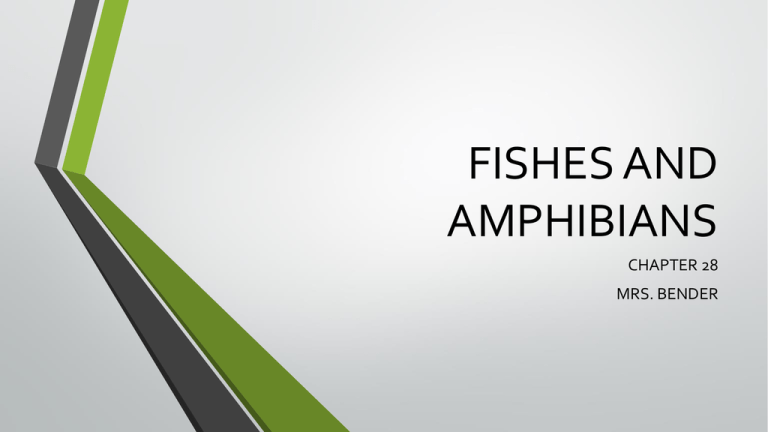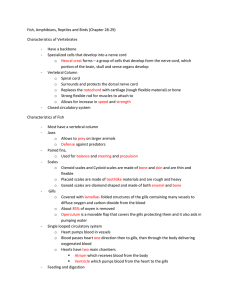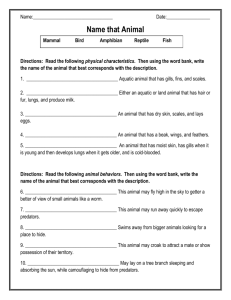FISHES AND AMPHIBIANS
advertisement

FISHES AND AMPHIBIANS CHAPTER 28 MRS. BENDER AMPHIBIANS • Begin life as aquatic and live on land as adults • Modern amphibians are descendants of tetrapods Adaptions to Land • Air less buoyant than water, so move against gravity causing limbs to develop along with skeletal and muscular systems • Cant remove dissolved Oxygen from water developed lungs, which are more efficient • Water retains heat, on land temperature change more easily so need to develop behavioral and physical adaptations for protection • Development of ears to sense sound • Live in variety of biomes Characteristics of Amphibians • Begin life as aquatic larvae then metamorphosis for land • Cold blooded, ectotherms, obtain their body heat from the external environment • As adults: four legs • Moist skin with no scales • Gas exchange through skin • Lungs • Double loop circulatory system Feeding and Digestion • Frog larvae are herbivores • Salamander larvae are carnivores • Adults are both predators and feed on invertebrates and small vertebrates • Mouth…esophagus….stomach (digestion begins)…small intestine (receives enzymes from pancreas, food is absorbed into blood stream)….large intestine…cloaca…(chamber at the end on intestine that receives digestive wastes, urinary wastes, and egg and sperm before they leave body) Excretion • Filter wastes from blood through their kidneys • Excrete either ammonia or urea as waste products of cellular metabolism • Ammonia is the end product of protein metabolism and is excreted by amphibians that live in water • Urea is produced by land amphibians, made from ammonia in the liver and is stored in the urinary bladder until eliminated through the cloaca Respiration • As larvae exchange gases through gills and skin • As adults, most use lungs and through their thin moist skin, and through the lining of their mouth cavity Circulatory System • Double loop system • • First loop moves oxygen-poor blood from the heart to pick up oxygen in the lungs and skin, and moves the oxygen-filled blood back to the heart Second loop blood filled with oxygen from the heart through the vessel to the body • Three chambered heart • Atrium • • • Right receives deoxygenated blood from the body Left receives oxygenated blood from lungs Ventricle • One chamber blood mixes before sent out to body Reproduction • Lay eggs in water to be fertilized by males (frogs) • Eggs do not have shells or protective covering • Sticky substance covers to adhere • Tadpoles use gills and only have two chambered heart Amphibian diversity • Order Anura • • • • Frogs powerful legs, moist smooth skin Toads small hops, dry bumpy skin, have gland which produce foul taste Order Caudata • • Frogs and toads Salamanders and newts • • Salamanders, four legs Newts are generally aquatic Order Gymnophiona • Caecilians • • • Legless and worm like Burrow in soil and feed on worms and invertebrate Internal fertilization Characteristics of Vertebrates • Have a backbone • Specialized cells that develop into a nerve cord • Neural crest forms – a group of cells that develop form the nerve cord, which portion of the brain, skull and sense organs develop • Vertebral Column • Spinal cord • Surrounds and protects the dorsal nerve cord • Replaces the notochord with cartilage (tough flexible material) or bone • Strong flexible rod for muscles to attach to • Allows for increase in speed and strength • Closed circulatory system Characteristics of Fish • Most have a vertebral column • Jaws • Allows to prey on larger animals • Defense against predators • Paired fins, • Used for balance and steering and propulsion Characteristics of Fish • Scales • Ctenoid scales and Cycloid scales are made of bone and skin and are thin and flexible • Placoid scales are made of toothlike materials and are rough and heavy • Ganoid scales are diamond shaped and made of both enamel and bone • Gills • Covered with lamellae- folded structures of the gills containing many vessels to diffuse oxygen and carbon dioxide from the blood • About 85% of oxyen is removed • Operculum is a movable flap that covers the gills protecting them and it also aids in pumping water Characteristics of Fish • Single looped circulatory system • Heart pumps blood in vessels • Blood passes heart one direction then to gills, then through the body delivering oxygenated blood • Hearts have two main chambers • Atrium which receives blood from the body • Ventricle which pumps blood from the heart to the gills Feeding and digestion • Fish swallow food passes through the esophagus to the stomach where digestion begins • Pyloric ceca a small pouch at the junction of the stomach and the intestine that secretes enzymes for digestion and absorption into the blood stream Excretion • The main functional unit of the kidney is the nephron, which is a filtering unit that helps maintain the salt and water balance of the body • Some cellular wastes excreted by the gills • Cellular wastes are filtered by kidneys Brain and senses • Nervous system consists of a brain and spinal cord • Cerebellum is involved in coordinating movement and controlling balance • Receptors that sense smell and detect chemicals in the environment • Olfactory bulbs record and respond to incoming chemical input • Color vision, optic lobes responsible for visual input • Cerebrum coordinates input from other parts of the brain • Medulla oblongata controls the internal organs • Lateral line system are special receptors that enable fish to detect movement and it keeps them upright and balanced Reproduction • External fertilization • Spawning in when females and males release gametes near each other in the water • Sharks reproduce internally Movement • Streamlined bodies • Mucus that lubricates surface to reduce friction • Swim bladder is a gas-filled space that allows fish to control their depth Classes of Fish • Jawless fish • Class Myxini is the hagfish • No scales, eel like shape, no fins, no bony skeleton • Have a notocord • Live on sea floor and feed on dead fish or invertebrate • Produce slime to prevent from being caught by predators • Class Cephalaspidomorphi • Lampreys • No scales, eel like shape, no fins, no bony skeleton • Have a notochord • parasitic CLASSES OF FISH • Cartilaginous fish • Body made of cartilage • Class Chonodrichthyes • Sharks, skates, rays • Several rows of teeth • Streamlined bodies • Sense chemicals in water • Lateral lines • Whale sharks are filter feeders CLASSES OF FISH • Bony fish • Class Osteichthyes • Rayed fish : most fish today • Lobed fish have muscular joints like land vertebrate •Use lungs to exchange air like the lung fish






